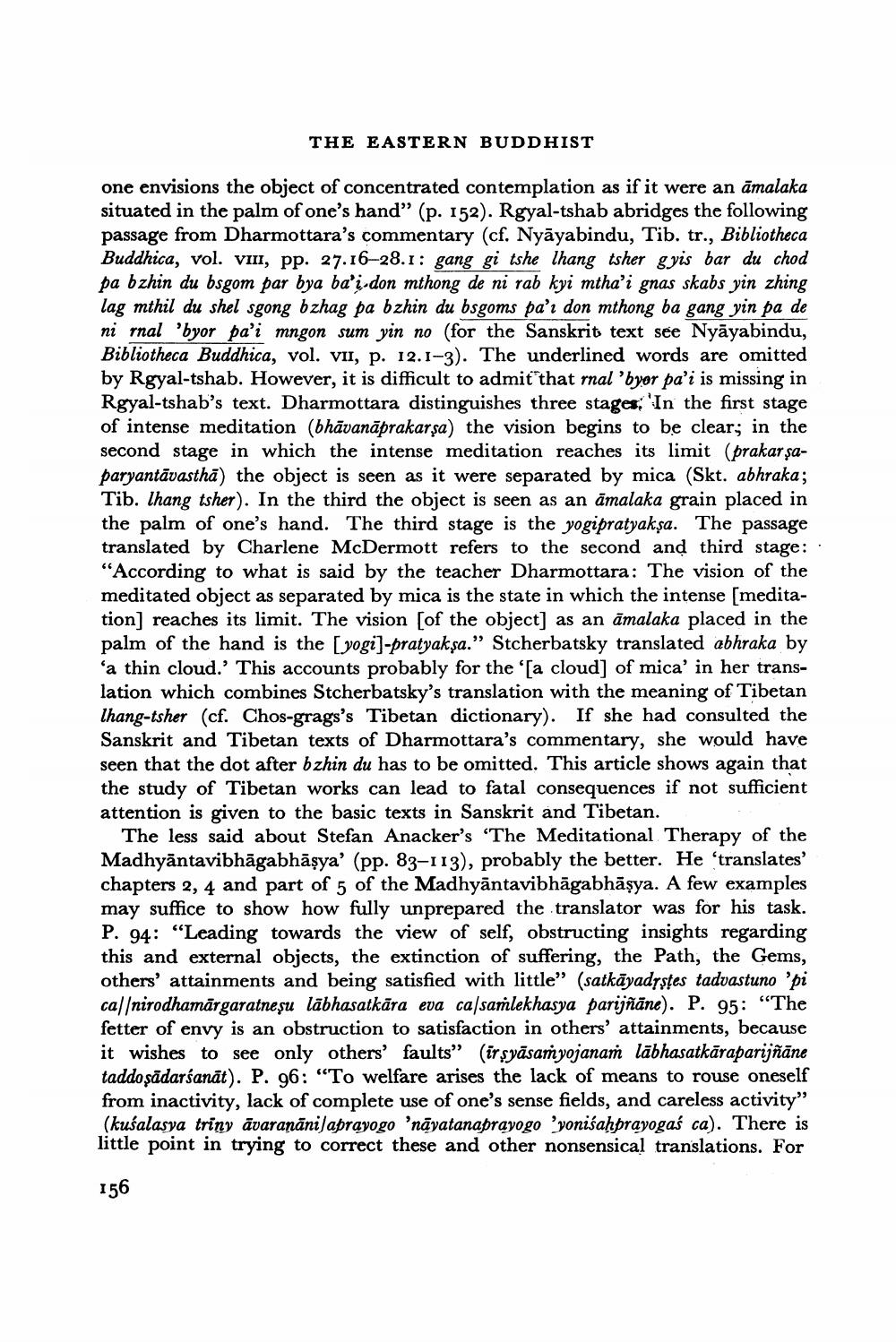________________
THE EASTERN BUDDHIST
one envisions the object of concentrated contemplation as if it were an āmalaka situated in the palm of one's hand” (p. 152). Rgyal-tshab abridges the following passage from Dharmottara's commentary (cf. Nyāyabindu, Tib. tr., Bibliotheca Buddhica, vol. VIII, pp. 27.16–28.1: gang gi tshe lhang tsher gyis bar du chod pa bzhin du bsgom par bya ba'i-don mthong de ni rab kyi mtha'i gnas skabs yin zhing lag mthil du shel sgong bzhag pa bzhin du bsgoms pa'r don mthong ba gang yin pa de ni rnal 'byor pa'i mngon sum yin no (for the Sanskrit text see Nyāyabindu, Bibliotheca Buddhica, vol. VII, p. 12.1-3). The underlined words are omitted by Rgyal-tshab. However, it is difficult to admit that rnal 'byor pa'i is missing in Rgyal-tshab's text. Dharmottara distinguishes three stages: 'In the first stage of intense meditation (bhāvanāprakarsa) the vision begins to be clear; in the second stage in which the intense meditation reaches its limit (prakar şaparyantāvasthā) the object is seen as it were separated by mica (Skt. abhraka; Tib. Ihang tsher). In the third the object is seen as an amalaka grain placed in the palm of one's hand. The third stage is the yogipratyakşa. The passage translated by Charlene McDermott refers to the second and third stage: "According to what is said by the teacher Dharmottara: The vision of the meditated object as separated by mica is the state in which the intense (meditation) reaches its limit. The vision [of the object] as an āmalaka placed in the palm of the hand is the yogi)-pratyakşa.” Stcherbatsky translated abhraka by 'a thin cloud.' This accounts probably for the '[a cloud] of mica' in her translation which combines Stcherbatsky's translation with the meaning of Tibetan lhang-tsher (cf. Chos-grags's Tibetan dictionary). If she had consulted the Sanskrit and Tibetan texts of Dharmottara's commentary, she would have seen that the dot after bzhin du has to be omitted. This article shows again that the study of Tibetan works can lead to fatal consequences if not sufficient attention is given to the basic texts in Sanskrit and Tibetan.
The less said about Stefan Anacker's "The Meditational Therapy of the Madhyāntavibhāgabhāşya' (pp. 83-113), probably the better. He translates' chapters 2, 4 and part of 5 of the Madhyāntavibhāgabhāşya. A few examples may suffice to show how fully unprepared the translator was for his task. P. 94: "Leading towards the view of self, obstructing insights regarding this and external objects, the extinction of suffering, the Path, the Gems, others' attainments and being satisfied with little" (satkāyadīştes tadvastuno 'pi cal/nirodhamārgaratneşu läbhasatkāra eva ca/samlekhasya parijñāne). P. 95: “The fetter of envy is an obstruction to satisfaction in others' attainments, because it wishes to see only others' faults" (ir syāsamyojanam lābhasatkāraparijñāne taddošādarśanāt). P. 96: "To welfare arises the lack of means to rouse oneself from inactivity, lack of complete use of one's sense fields, and careless activity” (kusalasya triny avaranāni aprayogo 'nāyatanaprayogo 'yonisah prayogaś ca). There is little point in trying to correct these and other nonsensical translations. For
156




